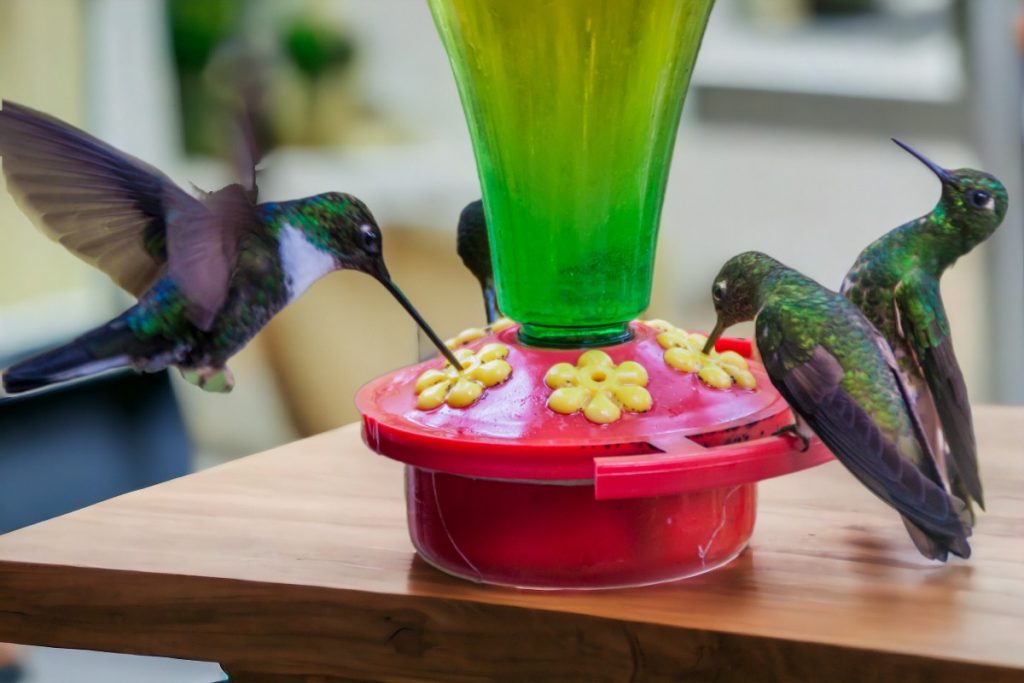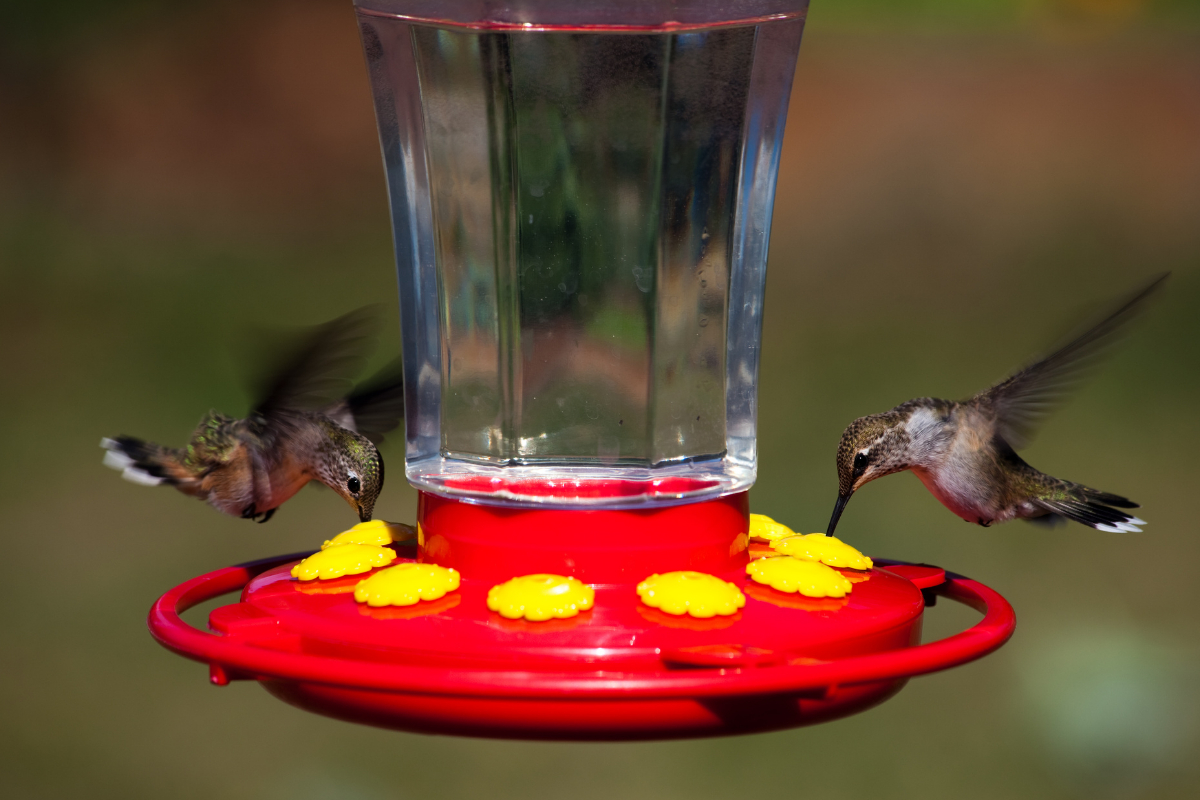To create the perfect nectar for a 16-oz hummingbird feeder, you’ll need to mix sugar and water in a 1:4 ratio. This means you should use 1/4 cup (4 tablespoons) of white granulated sugar and 1 cup of water. Following this ratio will provide an ideal concentration for the hummingbirds, ensuring they receive the energy they need without overloading on sugar.
Summary
In this post, we provide a comprehensive guide to creating the perfect sugar solution for your 16-oz hummingbird feeder. By using a 1:4 sugar-to-water ratio, you can ensure your hummingbirds receive the necessary energy without overloading on sugar.
We outline a step-by-step process for making the nectar, emphasizing the importance of using white granulated sugar and boiling the water to dissolve the sugar and kill bacteria.
Also, we discuss the importance of regularly cleaning and refilling your feeder to maintain a healthy environment for your hummingbirds.
With these guidelines, you can create a welcoming and nourishing space for these beautiful birds to thrive in your garden.
Related post to read: 15 Best Hummingbird Feeders.

A Step-by-Step Guide To Creating the Perfect Sugar Solution For 16-OZ Hummingbird Feeder:
Gather Your Ingredients and Supplies
To create the sugar solution for your 16-oz hummingbird feeder, you’ll need the following:
1/4 cup (4 tablespoons) of white granulated sugar
1 cup of water
A small saucepan
A stirring spoon
A measuring cup and spoons.
Boil the Water
Heat the water in a small saucepan over medium-high heat until it reaches a rolling boil. Boiling the water is important, as it will help dissolve the sugar and kill any bacteria or mould spores that might be present.
Dissolve the Sugar
Add the measured sugar to the boiling water, stirring continuously until the sugar is completely dissolved. This should only take a couple of minutes. Be careful not to overcook the mixture, as this can change the concentration of the sugar solution and make it less appealing to hummingbirds.
Cool the Solution
Remove the saucepan from the heat and allow the sugar solution to cool to room temperature. This may take up to an hour, depending on the temperature of your kitchen. Cooling the solution is crucial, as hot liquid can damage your hummingbird feeder or harm the birds.
Fill Your Feeder
Once the sugar solution has cooled, carefully pour it into your 16-oz hummingbird feeder, ensuring that it does not overfill the container. If there’s any leftover solution, you can store it in an airtight container in the refrigerator for up to a week.

Cleaning and Refilling Your Feeder To Maintain a Healthy Feeding Environment:
Cleaning Frequency
It’s essential to keep your hummingbird feeder clean and free of bacteria, mould, and debris that could harm the birds. Aim to clean your feeder every 3-5 days, especially during hot weather when the sugar solution can spoil more quickly.
Cleaning Procedure
To clean your feeder, empty any remaining solution and disassemble the feeder as much as possible. Use warm, soapy water and a brush to scrub all parts of the feeder, paying particular attention to any crevices or areas that may harbour bacteria. Rinse the feeder thoroughly with clean water to ensure all soap residue is removed.
Refilling Your Feeder
After cleaning and reassembling your feeder, refill it with fresh sugar solution made using the steps outlined earlier in this post. Remember to always let the solution cool to room temperature before filling your feeder.
Conclusion
By following these simple steps, you can create the perfect sugar solution for your 16-oz hummingbird feeder, attracting these fascinating creatures to your backyard and providing them with a safe and nutritious source of energy. Remember to maintain a clean and healthy feeding environment by regularly cleaning and refilling your feeder, ensuring the well-being of your tiny, feathered visitors.
In addition to providing a sugar solution, consider planting native flowers that are rich in nectar to supplement the hummingbirds’ diet and offer them a more natural feeding experience. By creating a haven for hummingbirds in your garden, you’ll be rewarded with their delightful presence, bringing life and colour to your outdoor space.
With these tips and tricks in mind, you’ll be well on your way to becoming a hummingbird enthusiast, nurturing these remarkable birds and contributing to their conservation. So, go ahead and set up that 16-oz hummingbird feeder, mix up that perfect sugar solution, and watch as your garden becomes a bustling hub of hummingbird activity.
Enjoy the beauty and wonder that these tiny birds bring to your outdoor sanctuary, and share your newfound knowledge with fellow bird lovers to spread the joy of hummingbird watching.
FAQs – How Much Sugar Do I Put In A 16-OZ Hummingbird Feeder?
Q: How much white sugar do I need for a 16-oz hummingbird feeder?
A: You need 1/4 cup (4 tablespoons) of white granulated sugar for a 16-oz hummingbird feeder.
Q: What is the ratio of sugar to water for hummingbird nectar?
A: The ideal ratio of sugar to water for hummingbird nectar is 1:4.
Q: Can I use brown sugar or raw sugar for hummingbird nectar?
A: No, you should use white granulated sugar, as brown sugar, raw sugar, and other unrefined sugars can harm hummingbirds.
Q: Can I use artificial sweeteners in my hummingbird food recipe?
A: No, artificial sweeteners should be avoided, as they do not provide the necessary energy that hummingbirds require.
Q: How many cups of water do I need for a 16-oz hummingbird feeder?
A: You need 1 cup of water for a 16-oz hummingbird feeder.
Q: Can I store extra sugar water for future use?
A: Yes, you can store extra sugar water in an airtight container in the refrigerator for up to a week.
Q: What is the ideal temperature of water for hummingbirds?
A: Room temperature water is ideal for hummingbirds, as hot water can damage the feeder or harm the birds.
Q: How often should I clean and refill my hummingbird feeder?
A: Clean and refill your hummingbird feeder every 3-5 days, especially during hot weather.
Q: Can I use organic sugar instead of regular table sugar for hummingbird nectar?
A: Yes, you can use organic sugar as long as it is white and granulated, similar to regular table sugar.
Q: What is a homemade hummingbird food recipe?
A: A homemade hummingbird food recipe consists of mixing 1/4 cup of white granulated sugar with 1 cup of water, boiling the mixture, and then letting it cool before filling the feeder.
Q: Are glass hummingbird feeders better than plastic ones?
A: Glass hummingbird feeders are generally more durable and easier to clean than plastic ones, but both types can be used effectively.
Q: How can I keep ants away from my hummingbird feeder?
A: Using a built-in ant moat or adding one to your feeder can help deter ants from reaching the nectar.
Q: What natural food sources can supplement hummingbird nectar?
A: Planting native flowers rich in nectar can provide additional natural food sources for hummingbirds.
Q: Can I use plain water in my hummingbird feeder if I run out of nectar?
A: While plain water can be a temporary solution, it does not provide the necessary energy that hummingbirds need, so it is important to replace it with nectar as soon as possible.
Q: How do I make homemade nectar for hummingbirds?
A: To make homemade nectar, mix 1/4 cup of white granulated sugar with 1 cup of water, boil the mixture, and let it cool before filling your feeder.
Q: How do I attract more hummingbirds to my backyard?
A: Make your hummingbird feeders visible and supplement their diet by planting native flowers rich in nectar.
Q: What is the ideal hummingbird nectar recipe?
A: The ideal hummingbird nectar recipe consists of 1/4 cup of white granulated sugar and 1 cup of water mixed in a 1:4 sugar-to-water ratio.
Q: Can I use hot water to dissolve the sugar for hummingbird nectar?
A: Yes, boiling water helps dissolve the sugar and kill any bacteria or mould spores in the mixture, but let the solution cool to room temperature before filling the feeder.
Q: Can using too much sugar in the nectar recipe cause damage to hummingbirds?
A: Yes, using too much sugar can cause health issues for hummingbirds, so it’s important to stick to the 1:4 sugar-to-water ratio.
Q: What other types of sugar should be avoided when making hummingbird nectar?
A: In addition to brown sugar and raw sugar, you should avoid using powdered sugar, honey, and any sugar substitutes, as they can be harmful to hummingbirds. Stick to white granulated sugar for the safest and healthiest nectar.
